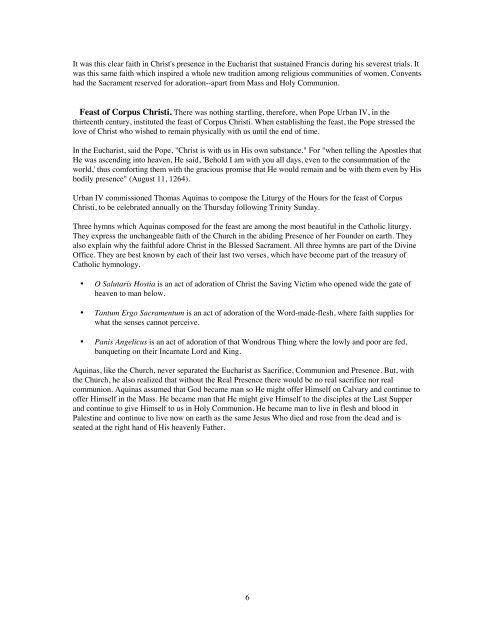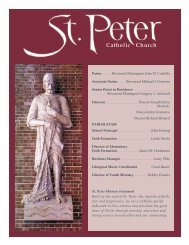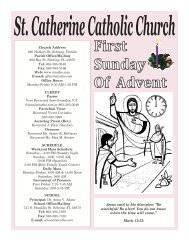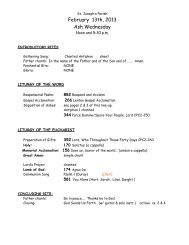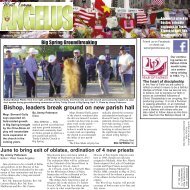The Perpetual Eucharistic Adoration Manual.pdf - Flocknote
The Perpetual Eucharistic Adoration Manual.pdf - Flocknote
The Perpetual Eucharistic Adoration Manual.pdf - Flocknote
You also want an ePaper? Increase the reach of your titles
YUMPU automatically turns print PDFs into web optimized ePapers that Google loves.
It was this clear faith in Christ's presence in the Eucharist that sustained Francis during his severest trials. It<br />
was this same faith which inspired a whole new tradition among religious communities of women. Convents<br />
had the Sacrament reserved for adoration--apart from Mass and Holy Communion.<br />
Feast of Corpus Christi. <strong>The</strong>re was nothing startling, therefore, when Pope Urban IV, in the<br />
thirteenth century, instituted the feast of Corpus Christi. When establishing the feast, the Pope stressed the<br />
love of Christ who wished to remain physically with us until the end of time.<br />
In the Eucharist, said the Pope, "Christ is with us in His own substance." For "when telling the Apostles that<br />
He was ascending into heaven, He said, 'Behold I am with you all days, even to the consummation of the<br />
world,' thus comforting them with the gracious promise that He would remain and be with them even by His<br />
bodily presence" (August 11, 1264).<br />
Urban IV commissioned Thomas Aquinas to compose the Liturgy of the Hours for the feast of Corpus<br />
Christi, to be celebrated annually on the Thursday following Trinity Sunday.<br />
Three hymns which Aquinas composed for the feast are among the most beautiful in the Catholic liturgy.<br />
<strong>The</strong>y express the unchangeable faith of the Church in the abiding Presence of her Founder on earth. <strong>The</strong>y<br />
also explain why the faithful adore Christ in the Blessed Sacrament. All three hymns are part of the Divine<br />
Office. <strong>The</strong>y are best known by each of their last two verses, which have become part of the treasury of<br />
Catholic hymnology.<br />
• O Salutaris Hostia is an act of adoration of Christ the Saving Victim who opened wide the gate of<br />
heaven to man below.<br />
• Tantum Ergo Sacramentum is an act of adoration of the Word-made-flesh, where faith supplies for<br />
what the senses cannot perceive.<br />
• Panis Angelicus is an act of adoration of that Wondrous Thing where the lowly and poor are fed,<br />
banqueting on their Incarnate Lord and King.<br />
Aquinas, like the Church, never separated the Eucharist as Sacrifice, Communion and Presence. But, with<br />
the Church, he also realized that without the Real Presence there would be no real sacrifice nor real<br />
communion. Aquinas assumed that God became man so He might offer Himself on Calvary and continue to<br />
offer Himself in the Mass. He became man that He might give Himself to the disciples at the Last Supper<br />
and continue to give Himself to us in Holy Communion. He became man to live in flesh and blood in<br />
Palestine and continue to live now on earth as the same Jesus Who died and rose from the dead and is<br />
seated at the right hand of His heavenly Father.<br />
6


